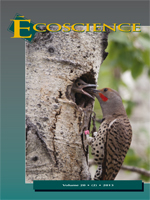Most plants that are dispersed by seed-caching animals are large, woody trees that produce large, nutritious nuts. But a few species dispersed in this way are relatively small shrubs or perennial herbs. Wild peony (Paeonia brownii) is a perennial herb in western North America that is dispersed by seed-caching rodents such as chipmunks (Tamias sp.), deer mice (Peromyscus mamculatus), and pocket mice (Perognathus parvus). These rodents harvest seeds from the dehiscent, pendant pods and transport them short distances (most <20 m) and cache 1 or a few seeds from 0 to 15 mm deep in soil. Unrecovered seeds germinate in the spring. Unlike most nuts, peony seeds are not highly preferred food items; they are rich in carbohydrates and low in lipids and protein. Rodents remove peony seeds slowly compared to Jeffrey pine (Pinus jeffreyi) seeds, which are highly preferred by rodents and dispersed in the same manner. The low preference for peony seeds may benefit the plants: peony seeds are slow to be harvested and cached, but also slow to be removed from caches and eaten. Small herbaceous plants cannot produce large crops of large, attractive seeds to satiate potential seed dispersers, as do most nut-bearing trees, so producing low-preference food items probably helps these types of plants to ensure that some of the seeds survive to germinate.
How to translate text using browser tools
1 June 2013
Dispersal of an Herbaceous Perennial, Paeonia brownii, by Scatter-Hoarding Rodents
Sarah C. Barga,
Stephen B. Vander Wall
ACCESS THE FULL ARTICLE

Ecoscience
Vol. 20 • No. 2
June 2013
Vol. 20 • No. 2
June 2013
cache
caching
entreposage dispersé de réserves
food hoarding
granivorie
granivory
mutualism




